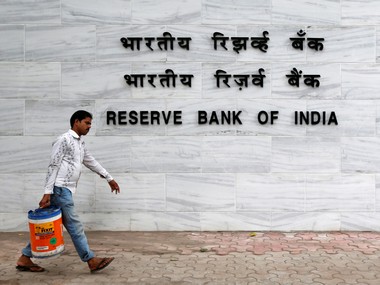Mumbai: An intense cash shortage in India could force the central bank to cut interest rates to a six-year low on Wednesday as Prime Minister Narendra Modi’s currency gamble threatens to hit nearly every aspect of the economy, from consumers to supply chains. A majority of the nearly 60 analysts polled by Reuters predict the Reserve Bank of India (RBI) will cut the repo rate by 25 basis points (bps) to 6.00 percent, the lowest since November 2010, while six predicted a deeper 50 bps cut. Pressure on the RBI and Governor Urjit Patel to act has grown since Modi stunned the country on Nov. 8 with a drastic plan to abolish 500 and 1,000 rupee notes ($7.35-14.70), removing 86 percent of the currency in circulation in a bid to crack down on India’s “shadow economy.” Data so far shows the measure has hit the cash-reliant economy more than expected: auto sales plunged and services sector activity dived into contraction last month for the first time in 1-1/2 years. The prospect that India’s robust growth will be derailed could offset any worries about a volatile global environment, which saw the rupee INR=D2 sink to a record low last month as part of a sell-off in emerging market assets. [caption id=“attachment_3126520” align=“alignleft” width=“380”]  Representational image. Reuters[/caption] According to Moneycontrol, “the RBI, guided by the newly-formed six-member monetary policy committee (MPC), is widely expected to cut its key lending rate — the repo rate — by 25 basis points to 6 percent. The MPC’s decision will be likely influenced by two factors: (a) the fall in consumer and investment spending because of the currency drain out, and (b) the outlook on inflation and the rupee’s value. In recent history, rarely has a single policy decision in the financial world had such an immediate impact as India’s move to retire old Rs 500 and Rs 1,000 currency notes.” Analysts say the RBI has room to act given consumer inflation eased in October to 4.20 percent, the slowest pace in 14 months and below the RBI’s target of 5 percent for March 2017. “We expect the RBI monetary policy committee (MPC) to cut rates by 25 basis points,” said Radhika Rao, an economist with DBS Bank, in a note. “While lingering external uncertainties raise the odds of a no-move, the RBI MPC is likely to take a growth supportive stance to offset downside risks to growth from the demonetisation effort.” A rate cut is not without risks. It would mark a second consecutive 25 bps easing by the six-member MPC, and some foreign investors warn it could raise concerns about whether the central bank is losing its focus on inflation. A cut would also come at a time when emerging markets are under pressure after the election of Donald Trump as U.S. president last month sparked a surge of capital flows back into the United States, a trend that could accelerate as the Federal Reserve gears up to raise interest rates next week. In India, foreign investors sold a net $4.7 billion in debt and equities in November even, though the country is seen as in better shape than other emerging markets. But a rate cut would signal the RBI’s priority is in supporting the economy, which grew an annual 7.3 percent between July and September, the fastest rate for a large economy in the world but still below the levels needed to sustain full employment. Investors will also want more details from Patel about how the RBI is managing the process of demonetisation after coming under criticism from market participants for frequently announcing adjustments to its policies. Most analysts say the RBI will likely partly roll back a directive for banks to place their entire deposits under the central bank’s cash reserve ratio in a bid to absorb the extra liquidity generated by the government’s banknotes move. The need to keep it in place has eased after the government announced last week it would raise the issuance of special bonds to soak up the liquidity. Ahead of the Reserve Bank of India (RBI) bi-monthly monetary policy review, the Indian equities markets opened on flat note. Investors are cautious ahead of the key announcement, and expect the central bank to ease its key lending rates. The key Indian indices traded marginally in green during the early morning trade session, as healthy buying was witnessed in oil and gas, automobile and metal stocks. The wider 51-scrip Nifty of the National Stock Exchange (NSE) inched up by 17.35 points or 0.21 per cent to 8,160.50 points. The barometer 30-scrip sensitive index (Sensex) of the BSE, which opened at 26,456.21 points, traded at 26,445.67 points (at 9.25 a.m.) – up 52.91 points or 0.20 per cent from the previous close at 26,392.76 points. The Sensex has touched a high of 26,469.93 points and a low of 26,418.05 points during the intra-day trade so far. The BSE market breadth was tilted in favour of the bulls – with 931 advances and 326 declines. On Tuesday, the equity markets closed on a flat note as profit booking and caution ahead of key global events capped gains. The barometer index was up 43.66 points or 0.17 per cent, while the NSE Nifty rose by 14.40 points or 0.18 per cent. With inputs from IANS and Reuters
RBI monetary policy as it happened: Disappointed by status quo, says SBI chief
Ahead of the Reserve Bank of India (RBI) bi-monthly monetary policy review, the Indian equities markets opened on flat note on Wednesday. Investors are cautious ahead of the key announcement, and expect the central bank to ease its key lending rates.
)
SBI chairman Arundhati Bhattacharya on RBI announcement
SBI chairman Arundhati Bhattacharya tells CNBC TV18 that she is disappointed by the status quo announcement, calling it a non-event.
We expected at least a 25 basis point cut.
Urjit Patel might have kept three things in mind while taking the decision: the rising oil prices, stabilised commodity prices and the certain hike in US Federal Reserve rate.
There has been a demand disruption in the near past.
The rate cut might have helped market sentiment. But we are relieved that additional CRR is now taken away. We believe that ample liquidity will drive rates down and there may be lowering of rates in future.
Chief Economic Advisor Arvind Subramanian
RBI took a bold and brilliant call. The move counters expectations and it is the right call in current circumstances. Interest rates across world except India has gone up considerably.
Market impact
After the central bank kept the bank rates unchanged, the Sensex dropped 155.89 pts to end at 26,236.87, while Nifty fell 41.10 pts to 8,102.05.
#Sensex drops 155.89 pts to end at 26,236.87; #Nifty falls 41.10 pts to 8,102.05.
— Press Trust of India (@PTI_News) December 7, 2016
RBI cuts growth forecast to 7.1 per cent, sees short-term disruption
The Reserve Bank cut the economy’s expansion forecast for current fiscal to 7.1 per cent, from 7.6 per cent earlier, saying that short-term disruption in economic activity and demand compression arising out of demonetisation have led to downside risks to growth.
The Indian economy expanded by 7.1 per cent and 7.3 per cent in the first and second quarter of the ongoing fiscal.
RBI said the impact of demonetisation should ebb with the progressive increase in the circulation of new currency notes and greater usage of non-cash based payment instruments in the economy.
RBI today kept short term lending rate unchanged saying it is adopting a wait and watch policy to see the effect of withdrawal of 500 and 1000 rupee notes from circulation.
RBI said the second quarter GDP quarter was lower than projected because of deeper than expected slowdown in industrial activity. “Manufacturing slowed down both sequentially and on an annual basis, with weak demand conditions and the firming up of input costs dragging down the profitability of corporations,” it said.
PTI
RBI monetary policy
The headline inflation is projected at 5 per cent by the fourth quarter of 2016-17 with risks tilted to the upside but lower than in the October policy review.
The fuller effects of the house rent allowances under the Seventh Pay Commission award are yet to be assessed, pending implementation, and have not been reckoned in this baseline inflation path.
The withdrawal of old high value currency notes could transiently interrupt some part of industrial activity in November-December due to delays in payments of wages and purchases of inputs, although a fuller assessment is awaited.
In the services sector, the outlook is mixed with construction, trade, transport, hotels and communication impacted by temporary old currency notes effects, while public administration, defence and other services would continue to be buoyed by the 7th Central Pay Commission (CPC) award and one rank one pension (OROP).
The central bank also said that almost Rs 12 lakh crore out of total Rs 14.5 lakh crore in scrapped notes have already been deposited in banks. RBI has also withdrawn 100 per cent incremental Cash Reserve Ratio (CRR) from December 10, a move that would allow banks to retain the deposits coming to them as part of demonetisation.
All the six members of Monetary Policy Committee headed by the RBI Governor voted in favour of the today’s decision. In the view of the Committee, this bi-monthly review is set against the backdrop of heightened uncertainty.
Globally, the imminent tightening of monetary policy in the US is triggering bouts of high volatility in financial markets, with the possibility of large spillovers that could have macroeconomic implications for emerging markets.
While supply disruptions in the backdrop of currency replacement may drag down growth this year in India, it is important to analyse more information and experience before judging their full effects and their persistence.
Short-term developments that influence the outlook disproportionately warrant caution with respect to setting the monetary policy stance.
“On balance, therefore, it is prudent to wait and watch how these factors play out and impinge upon the outlook. Accordingly, the policy repo rate has been kept on hold in this review, while retaining an accommodative policy stance,” the RBI said.
PTI
Demonetisation to impact activities in cash-intensive sectors
Demonetisation could result in short-run disruptions in economic activity in cash-intensive sectors like retail trade, hotels, restaurants and transportation, and the unorganised sector.
The withdrawal of old Rs 500 and 1,000 notes “could result in a possible temporary reduction in inflation of the order of 10-15 basis points in Q3 (October-December period”.
RBI, however, kept retail inflation target of 5 per cent for the fourth quarter of the fiscal and the medium-term target of 4 per cent within a band of +/- 2 per cent while supporting growth.
Monetary Policy Committee felt that the assessment is clouded by the still unfolding effects of the withdrawal of specified bank notes (SBNs).
“The outlook for GVA (gross value added) growth for 2016-17 has turned uncertain after the unexpected loss of momentum by 50 basis points in Q2 and the effects of the withdrawal of SBNs (Rs 500/1,000 notes) which are still playing out,” the policy document said.
Downside risks in the near term could travel through two major channels. One is short-run disruptions in economic activity in cash-intensive sectors such as retail trade, hotels and restaurants and transportation, and in the unorganised sector.
The second channel is aggregate demand compression associated with adverse wealth effects.
The impact of the first channel should, however, ebb with the progressive increase in the circulation of new currency notes and greater usage of non-cash based payment instruments in the economy while the impact of the second channel is likely to be limited.
PTI
RBI and government singing the same tune
One must note that the RBI governor Urjit Patel was broadly singing the same tune as the government on the demonetisation issue.
The governor played down the impact of the demonetisation process on the economy beyond the short term, contradicting what the many private economists have warned.
Patel also made it a point to state that there is no ‘trust deficit’ in the public post the demonetisation and even said most people are lauding the government move since it will help curb black money, terror funding and fake currency in the system.
The governor also spoke about the benefit of moving to a cashless economy, something the government has been highlighting all along.
The big take away is that Patel hasn’t given any room for demonetisation critics to speculate that RBI and government are not on the same page on the demonetisation issue.
Following are the highlights of RBI’s fifth bi-monthly monetary policy statement, 2016-17:
Repo rate unchanged at 6.25 percent, Reverse Repo at 5.75 percent
Cash reserve ratio or CRR unchanged at 4 percent
Cuts growth forecast to 7.1 percent, from 7.6 percent for this fiscal
Inflation target remains 5 percent for March 2017, upside risk
Demonetisation to lower prices of perishables, could reduce inflation by 10-15 basis points by December
All MPC members voted in favour of status quo in policy
Demonetisation to result in short-run disruptions in cash-intensive sectors
Crude price volatility, surge in financial market turbulence could put March end inflation target at risk
Foreign exchange reserve rose to all-time high of USD 364 billion on 2 December.
RBI injected Rs 1.1 lakh crore liquidity through OMO purchases this fiscal
Next monetary policy on 8 February.
PTI
Recaliberation of Rs 500 and 1,000 notes
Urjit Patel says recaliberation of Rs 500 and 100 notes has been fastened in last two weeks. Deputy Governor R Gandhi added that no decision has been taken on re-introducing Rs 1,000 notes.
Markets unfazed by policy outcome
Markets were not too worried about the RBI policy outcome. After the RBI’s monetary policy announcement of maintaining status quo in repo rate, the S&P BSE Sensex fell 228 points or 0.86 percent to 26164.82 from Tuesday’s close of 26392.76. However, it recovered some losses and currently trades at 26248.82, down 143.94 points or 0.55 percent. Rate sensitive stocks like SBI went down by 1.27 percent, ICICI Bank went down by 1.23 percent, HDFC Bank went down by 0.98 percent.
Withdrawal restrictions: Urjit Patel addresses concerns
“The money is your banks is yours. Yes there are withdrawal restrictions at the moment, but it is unlikely to a permanent feature,” says RBI governor Urjit Patel. “The demonetisation helps fight counterfeit currency problem, black money and funding of terrorist organisations. It is a not a long term issue and it is a transition issue only,” he added.
Can dates be pre-poned for depositing money?
“Choices of denomination are based on the needs of the people. As for pre-poning the date, it is a continous review, as of now the last date is 30 December,” says R Gandhi.
RBI plays down demonetisation woes; keeps rate unchanged
RBI has kept the bank rates unchanged and is playing down the negatives of demonetisation.
Creating denominations
“Choice of denomination is based on the manners in which people transact with denominations and this is the reason why Rs 2000 denomination was created. When we create denominations, we arrive at our conclusions after average needs,” says R Gandhi
Old notes in the banking sytem
R Gandhi says that old notes worth 11.55 Lakh crores have been deposited in the banks.
R Gandhi speaks on demonetisation
The decision to demonetise was not been taken in haste, but after long deliberations. The RBI and central government are conscious of the difficulties that public is facing because of demonetisation. RBI and the central government-run note presses are working to their full capacity. Between 10 November and 5 December, RBI provided 4 lakh crores worth of rupees. 19.1 billion pieces on demonetised notes have been provided to public.Hoarding of notes will help nobody.
Status quo in RBI monetary policy
The status quo in rates in the RBI policy has come as a bit of surprise since most economists were expecting at least a quarter percentage rate cut, some even a 0.5 percent rate cut. The RBI has held rates steady despite the fears that the economy is staring at a slowdown phase in the aftermath of the implementation of the demonetisation exercise. The central bank itself has lowered the GVA growth for 2016-17 is revised down from 7.6 per cent to 7.1 per cent. But, the RBI isn’t overly worried about growth slowing post the demonetisation.
Take a look at this statement:
“While supply disruptions in the backwash of currency replacement may drag down growth this year, it is important to analyse more information and experience before judging their full effects and their persistence – short-term developments that influence the outlook disproportionately warrant caution with respect to setting the monetary policy stance. If the impact is transient as widely expected, growth should rebound strongly.” Also, the RBI has cautioned about the sticky nature of core inflation (non food, non fuel inflation) closely ahead. Hence, it has chosen to hold rates for now. The statement gives emphasize to the accommodative policy stance, which means there may be rate cuts ahead.
Relief to banks
Banks will not have keep additional CRR from 10 December 2016,
RBI on seventh pay commission
Urjit Patel says seventh pay commission payments have not been disruptive to inflation outcome.
RBI Governor speaks
Urjit Patel starts addressing media about the monetary policy.
RBI on demonetisation
RBI says that growth will rebound strongly if demonetisation effect transient.
Consumer Price Index
CPI base effect seen unfavourable in December and February.
GDP growth lowered
RBI lowers GDP forecast for current fiscal from 7.6 percent to 7.1 percent.
Monetary policy stance remains accommodative
RBI says increment CRR withdrawn from December 10 fortnight.
No rate cut announced
RBI repo rate unchanged at 6.25 percent.
Higher likelihood for banks to pass on rate cut benefit to customers
Finanical markets have factored in a a 25 bps rate cut today. If the RBI announces a 0.50 per cent cut, that will surprise the markets and will sent a positive signal. There is a higher likelihood for banks to pass on the rate cut benefit to customers.
Expect RBI to cut rates by 50bps
The RBI is unlikely to make any comments on growth outlook, according to financial experts. Markets will react positively to such a rate cut, claim analysts.
RBI likely to cut rates
The Reserve Bank of India (RBI) is expected to cut interest rates next week and economists are set to chop growth and inflation forecasts after Prime Minister Narendra Modi’s currency crackdown rattled the economy and severely hurt consumption, a Reuters poll showed.
Modi’s outlawing of high-value bank notes last month, aimed at curbing corruption and tax evasion, has left the nation’s 1.2 billion population scrambling to exchange old notes for new and left many companies’ cash-reliant supply chains in tatters.
India’s economy expanded 7.3 percent in the July-September quarter from a year earlier, making it the fastest growing major country in the world. But it could easily lose top spot if some of the more pessimistic views that suggest growth could halve post-demonetisation come true.
It could also drag inflation down. At 4.2 percent in October, it is below the central bank’s early-2018 target of 5 percent.
Reuters
After demonetisation, RBI has become opaque
The slower demand induced by demonetisation is seen further pressuring the prices down. There is even a view that the entire process is deflationary. If it is indeed so, this would do more harm to the economy. The RBI is bound to give some clarity on this, including a revised estimate for inflation. Look out for the number.
One could easily argue that the central bank need not clarify all of these.
But given the grand scale at which the demonetisation is being rolled out and the way it is impacting the general public, there is a need for more transparency on the workings of the central bank. But, ironically, the RBI has gone into an opaque mode.
This has seriously dented the image of the central bank. The Bank officers’ confederation has even sought the resignation of Patel for not taking moral responsibility for the havoc in the financial system.
Read more here .
RBI Governor, Urjit Patel has been fairly quiet about demonetisation
Ever since demonetisation, the central bank and its governor Urjit Patel have both come under criticism for being silent about the steps taken. The two occasions when governor Patel spoke — interviews to PTI and Quint — he just made a customary assurance that the central bank is doing everything to reduce genuine customers’ pain.
The policy review today is a chance for Patel to clear all these charges. These are a few questions on everyone’s minds: Will he speak up? Will he reveal the status of printing of currency notes in its presses? How much rupee notes have been printed so far? How much more have to be printed to completely replace the demonetised currency? When does Patel think the situation will normalise?
Read more here .

Chennai Ranks #1 in Challan Checks: ACKO Insights for Smarter Car and Two Wheeler Insurance Decisions
Chennai leads India in challan checks, with drivers checking their e-challans over 5 times a month on average. Helmet non-compliance is the most broken rule, accounting for 34.8% of all traffic offences in Chennai. Regular digital challan checks help drivers avoid hefty fines, promote safe driving, and improve insurance premiums.
More Impact Shorts

)
)
)
)
)
)
)
)
)
)



